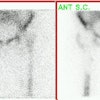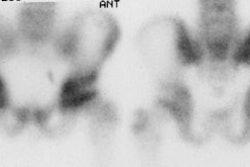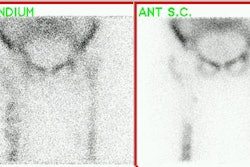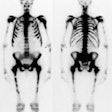J Nucl Med 2000 Oct;41(10):1682-8
Factors affecting sentinel node localization during preoperative breast
lymphoscintigraphy.
Haigh PI, Hansen NM, Giuliano AE, Edwards GK, Ye W, Glass EC.
Variable success rates for identifying axillary (AX) sentinel nodes in breast
cancer patients using preoperative lymphoscintigraphy have been reported. We
evaluated the effects of age, weight, breast size, method of biopsy, interval
after biopsy, and imaging view on the success of sentinel node identification
and on the kinetics of radiopharmaceutical migration. METHODS: Preoperative
breast lymphoscintigraphy was performed in consecutive breast cancer patients
from February 1998 to December 1998. The ipsilateral shoulder was elevated on a
foam wedge and the arm was abducted and elevated overhead. Imaging using this
modified oblique view of the axilla (MOVA) started immediately after peritumoral
injection of Millipore-filtered 99mTc-sulfur colloid and continued until AX
sentinel nodes were identified. Anterior views were obtained after MOVA. AX,
internal mammary (IM), and clavicular (CL) basins were monitored in all
patients. MOVA was compared with the anterior view for sentinel node
identification. Age, weight, breast size, method of biopsy, interval after
biopsy, and primary tumor location were evaluated for their effects on sentinel
node localization and transit times from injection to arrival at the sentinel
nodes. RESULTS: Seventy-six lymphoscintigrams were obtained for 75 patients. AX
sentinel nodes were revealed in 75 (99%) cases. IM or CL sentinel nodes were
found in 19 (25%) cases and were not related to tumor location; exclusive IM
drainage was present in 1 (1%) case. Identification of AX sentinel nodes was
equivalent with MOVA and anterior views in 18 (24%) patients, was better with
MOVA in 20 (26%) patients, and was accomplished only with MOVA in 38 (50%)
patients. Median transit time was 17.5 min (range, 1 min to 18 h) after
injection, and larger breast size was associated with increased transit time. No
effect of age, weight, biopsy method, interval from biopsy, or tumor location on
transit time was found. CONCLUSION: Use of MOVA can improve identification of AX
sentinel nodes. Although AX drainage is the predominant pattern, a tumor in any
portion of the breast can drain to IM sentinel nodes. Transit time was
influenced by breast size. Overall short arrival times with this technique allow
sentinel lymph node dissection to be performed on the same day as
lymphoscintigraphy.






